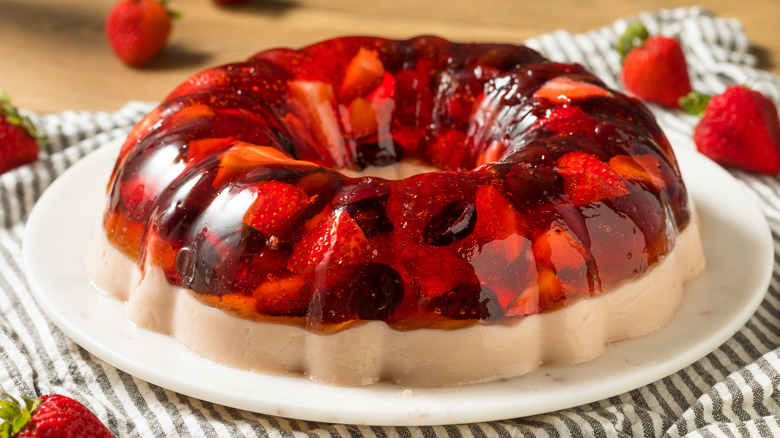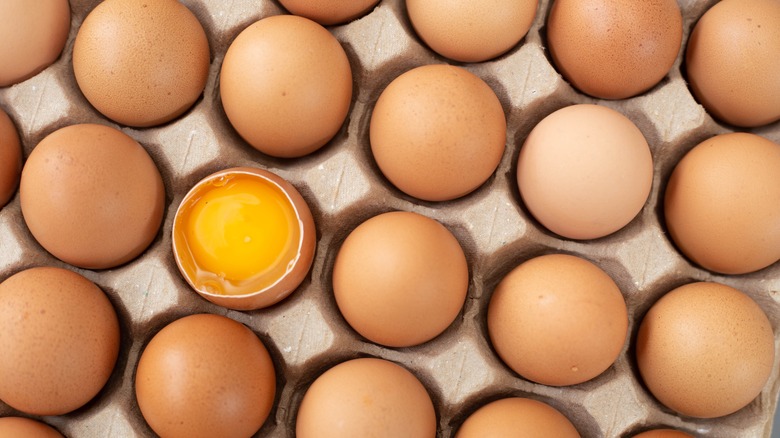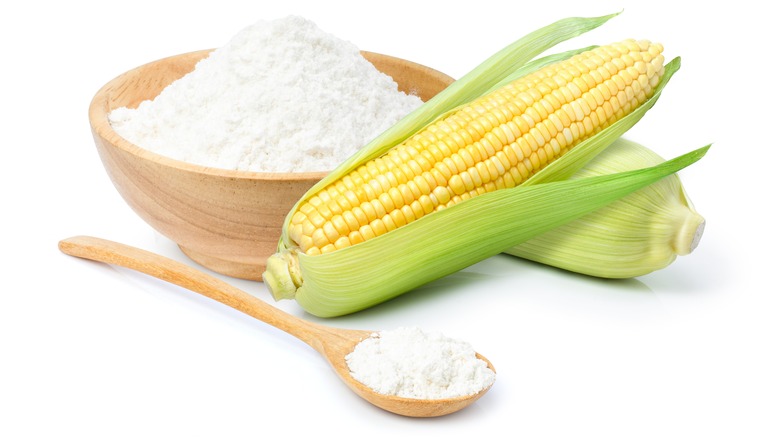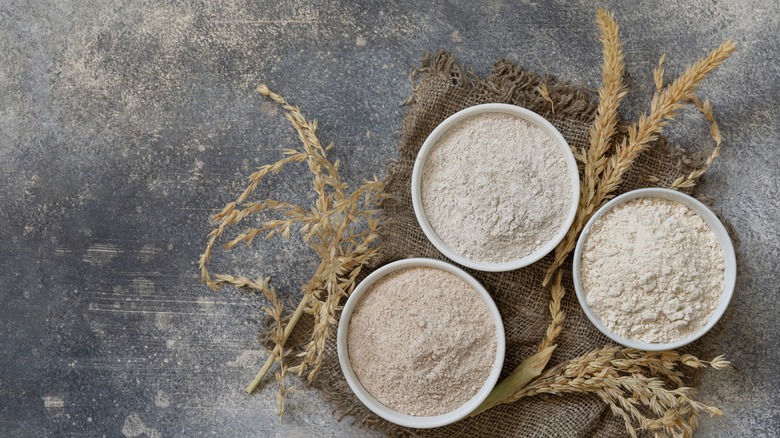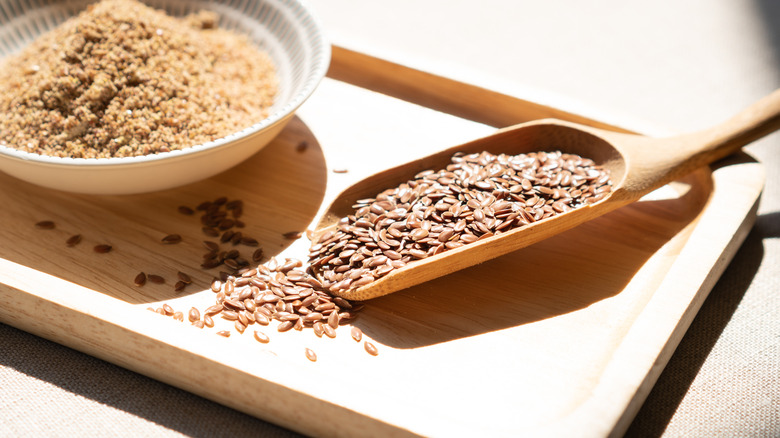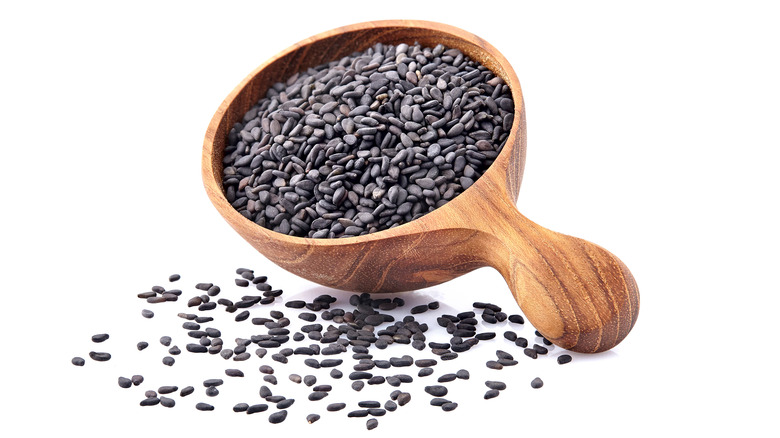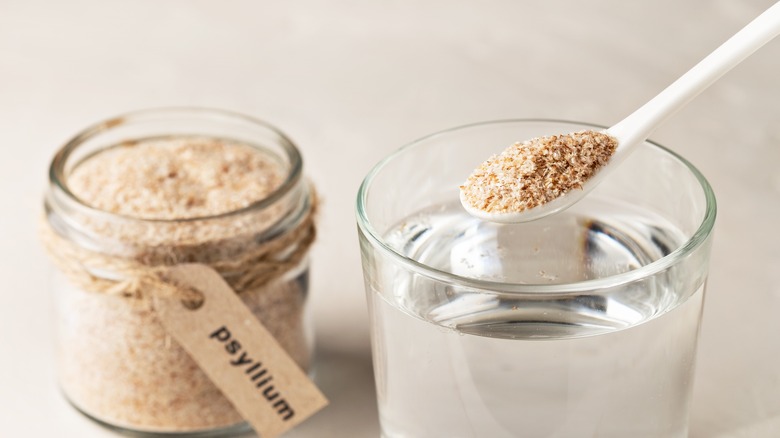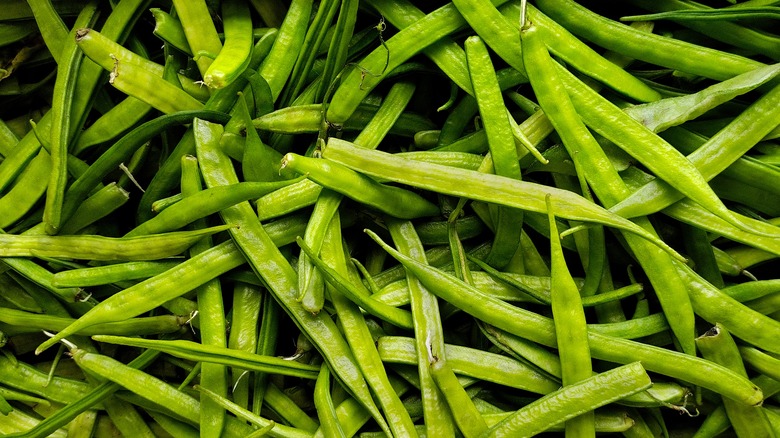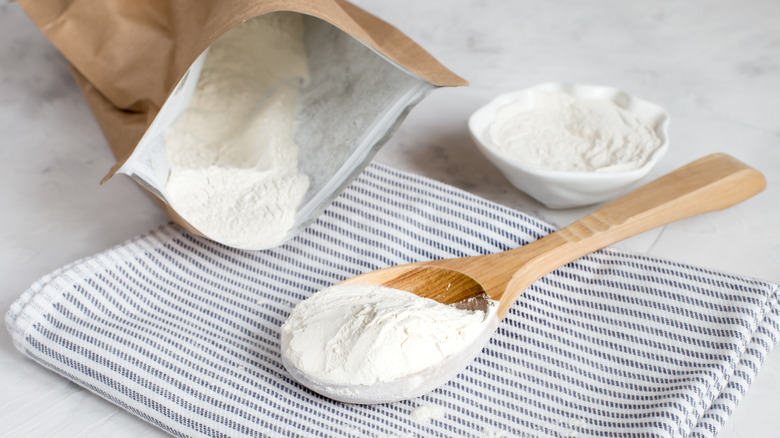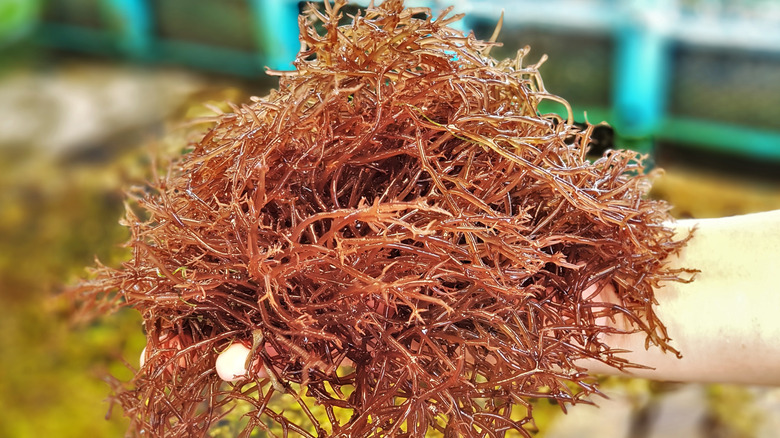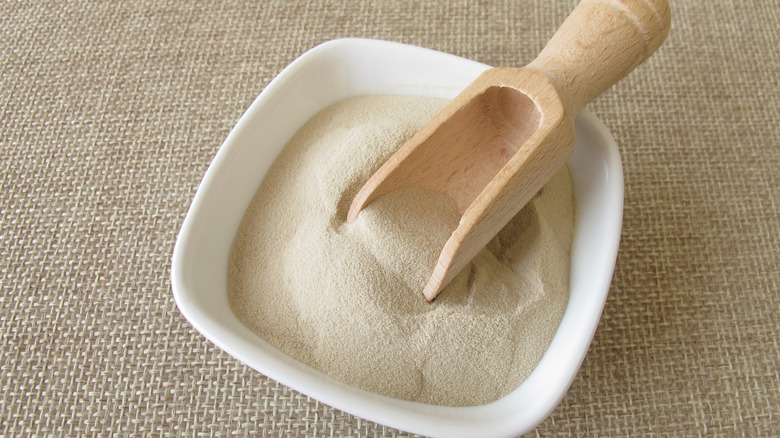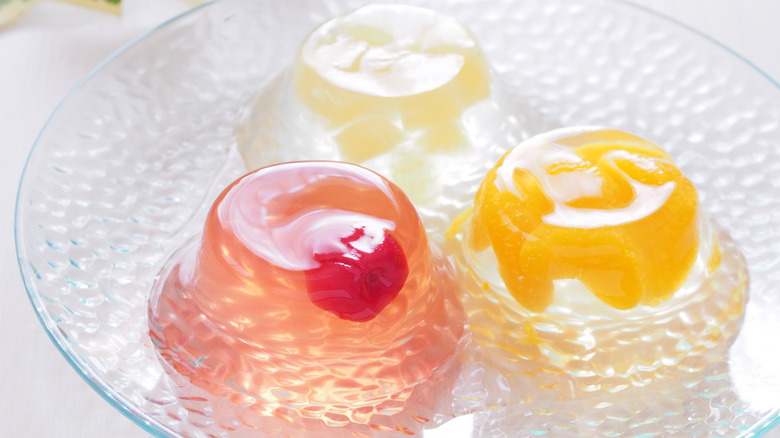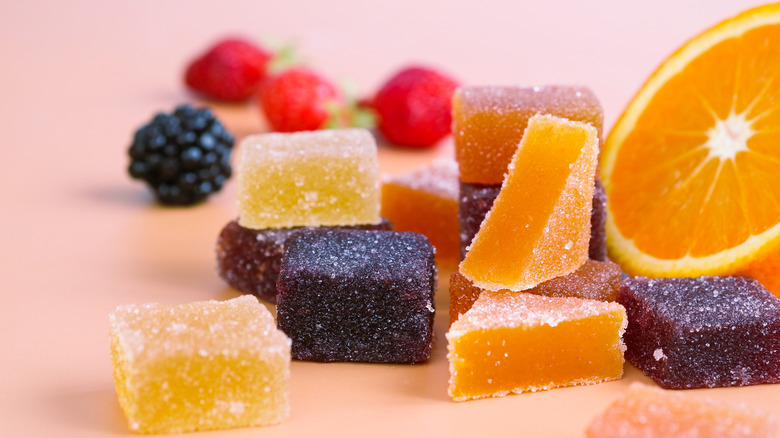12 Binding Agents And How To Use Them
Whether you're cooking or baking, many recipes require the use of a binding agent or a thickener. Activated by heat or other catalysts, these ingredients hold the rest of your recipe together and give it the perfect texture. Binding agents keep mixtures from separating, add structural support to delicate bakes, and make sauces smooth or jellies jiggly. And with binders long-used in commercial food products like Xanthan and guar gums now available for home cooking, the variety of binding agents at your local grocery store can be daunting.
If you've ever looked at different binding agents and wondered what the difference between them was, this is the guide for you. What are all of these binders, and do they work the same way? Which ones should you be using and when? These are 12 of the most-common binding agents used in cooking, where they come from, and how you can use them.
Eggs
Eggs are mostly made of water and long chains of highly elastic protein molecules. The bonds linking these proteins together are easily broken by heat or by beating air into the eggs. Proteins that have been denatured (changed from their original state) form new bonds, creating a dense web of molecules that traps air bubbles inside it. That's how beaten eggs or egg whites add a lighter, airier texture to baked goods. The protein web produced by beaten eggs sets and then coagulates when raised above a certain temperature (for a whole egg, it's about 156 degrees Fahrenheit), holding other ingredients together. This is why eggs work so well as a binding agent, not only in baking but also to help ingredients like breadcrumbs adhere to fried fish.
Eggs are the only non-vegan item in this list, so there are plenty of other options for binding agents if you're looking to avoid animal products. Egg substitutes are tricky in recipes where eggs are the main featured ingredient, but the good news is that in many recipes, they are far from irreplaceable. In baking, you can use a powdered egg replacer, replace an egg with vegetable oil and baking powder to replicate some of the lightness and richness eggs provide, or consider other binding agents.
Starch
Proteins are the key to the binding properties of eggs, but most of the ingredients on this list work as binders because of long-chain molecules called polysaccharides. Starch is a carbohydrate polysaccharide, a chain of sugar molecules that most green plants produce as a store of reserved energy. Heating polysaccharides causes them to unwind. As they bind back together, they trap water molecules between them, creating a tangled molecular web with a gel-like texture.
Cornstarch, the most-common cooking starch, gels at around 203 degrees Fahrenheit. As a thickener in soups, sauces, or pie fillings, cornstarch tends to form clumps when added directly to a hot liquid, so it should be mixed into a slurry with room-temperature water before being added to the recipe. Potato and arrowroot starch can be substituted for cornstarch in identical amounts.
Tapioca starch, derived from the cassava root, can also be used as a swap for cornstarch in a ratio of two parts tapioca to one part cornstarch, though the two have different properties. Cornstarch has a more opaque white appearance when cooked, while tapioca's finish is more translucent. Tapioca is more tolerant of freezing, while cornstarch is better at boiling. Another thing to note is that tapioca starch is generally more expensive than cornstarch, but the chewy, gelatinous texture it provides at high concentrations makes it prized for certain desserts, such as the pearls used in bubble tea.
Flour
Flour is essential in binding other ingredients in many baked goods and can also be used as a thickener in sauces and soups. Wheat flour contains both starch and protein (gluten) that create structure and bind molecules together when cooked. There seems to be a type of flour made from everything these days, so it's important to remember that not all flour works the same. Flours made from different ingredients have various binding properties due to a wide range of gluten and starch.
Some gluten-free flours, like rice flour, are still effective as binding agents because they contain a lot of starch: for example, rice flour porridge is used as a binder in some recipes for different types of kimchi to help the fiery chili paste adhere to the vegetables. However, other gluten-free flours like almond flour are ineffective binders on their own and require another binding agent to achieve the desired effect in baking. If you're considering using flour as a binding agent, consider the specific properties of the flour you choose. Like starch, flour needs to be cooked to be used as a binding agent and consumed safely, so it shouldn't be used in raw recipes.
Flaxseeds
Flaxseeds are another natural binding agent that contains a polysaccharide (in this case, fiber) that enables the seeds, when ground, to trap up to 30 times their weight in water, according to the National Library of Medicine. Grinding flaxseeds is also the best way to make their considerable nutrients (such as fiber and omega-3 fatty acids) available to our bodies, as whole flaxseeds may be difficult to digest.
1 tablespoon of ground flaxseeds plus 3 tablespoons of water (and a 15-minute wait) produces a gelatinous vegan "flax egg," equivalent to one egg in any recipe. The wait time is shortened to 2 minutes if you use boiling water. As flax eggs don't last long, only make what you plan to use immediately. Keep in mind that flax eggs will impart a flecked appearance and a slightly nutty flavor to your baked goods. They are also not the best egg substitute in any recipe that calls for a large volume of eggs or egg whites, but they work well in recipes like brownies, cookies, and waffles or even as an emulsifier in salad dressings.
Chia Seeds
Chia is a plant in the basil and mint family native to South America and cultivated there by Indigenous people since ancient times. Like flaxseeds, chia seeds are high in polysaccharide fiber, which makes them hygroscopic, which means they absorb and trap water to create a gel-like texture (up to 12 times their weight). Chia seeds are much smaller than flaxseeds, and water absorption will occur without grinding the seeds.
You can make a vegan "chia egg" to use as a binding agent in baking the same way you would make a flax egg, except you don't need to wait as long (2 to 5 minutes is sufficient). Chia seeds can also be used to thicken oatmeal and jelly or soaked in milk to make chia pudding, and because they are so tiny with no flavor on their own, it's easy to add them to a range of dishes for a boost of nutrition. Chia seeds add an especially unique texture, soft jelly with a hint of crunch, to drinks and desserts; a related seed with the same hygroscopic properties, known as tukmaria or "basil seed,” is often used this way in India and the Middle East.
Psyllium Husk
"Psyllium husk" refers to the outer seed coat of several species of a leafy plant in the genus Plantago, commonly known as plantains (but completely different from the "cooking banana" plantain). Like flax and chia seeds, psyllium seeds are rich in dietary fiber. The major commercial use of psyllium husk is in digestive health supplements like Metamucil, but it can also be used as a binder in vegan baking.
Of the other binding agents in this list, psyllium husk chemically resembles xanthan gum the most, but its higher viscosity enables it to bind more water. To make a psyllium egg, use a single teaspoon of psyllium powder and 3 tablespoons of water, which can be used as a substitute for one egg in baking, just like a chia or flax egg. Alternately, you can add a teaspoon of psyllium powder directly to your batter for every egg the recipe calls for and wait 10 minutes for the water and binding. Psyllium husk works particularly well as a binder for gluten-free flours, especially in bread, with a wheat-like flavor that is not unwelcome in many baked goods. Some brands, or homegrown varieties, may also add a gray or purplish color to the final product.
Guar gum
Guar gum is yet another fiber-rich extract from the husk of a seed: in this case, a bean called guar, guvar, or cluster bean, which is eaten as a vegetable in its native South Asia. Guar and xanthan gum are used similarly in commercial products as binding agents and stabilizers and are often confused with each other. It is an excellent binding agent for gluten-free baking, as it can give baked goods a comparable texture to those made with wheat flour but without an added flavor, color, or scent of its own. Bread recipes usually use more guar gum than other baked goods like cakes, up to a teaspoon of guar gum per cup of gluten-free flour.
Unlike the seed "eggs" mentioned earlier, when baking with guar or xanthan gums, you should add powdered gum to the dry ingredients rather than soaking it in water first. Guar gum has eight times the thickening power of cornstarch, so a little goes a long way. Unlike starch, guar gum's thickening properties are unaffected by temperature, meaning it can be added easily to smoothies, dressings, sauces, and soups, as well as frozen desserts, to give them a creamier texture and prevent ice crystals from forming. It's recommended to mix with an immersion blender to prevent clumping. While some prefer xanthan over guar gum, it's worth noting that the former is usually the more affordable of the two.
Xanthan gum
Especially helpful in emulsifying blended ingredients and preventing them from separating, xanthan gum is found in commercial products from salad dressing to toothpaste. Aside from a similar name, xanthan gum and guar gum have a lot in common. They are both flavorless, odorless powders, both widely used commercially but more recently accessible to home bakers, and both can provide the springy texture of gluten to gluten-free bakes or a velvety texture to smoothies, sauces, and dressings. Guar and xanthan gum can even be substituted for one another in the same proportion, and neither is affected by temperature.
So what are the differences between these two binding agents? In gluten-free baking, xanthan gum is said to recreate the texture of gluten more closely than guar gum. And, while xanthan gum is another polysaccharide, it's not derived from a plant like guar: it's produced by allowing a bacteria called Xanthomonas campestris (the source of the name) to ferment the sugars in corn or other grain. Because corn is typically used in its production, xanthan gum should be avoided by those who cannot consume corn products. Xanthan gum is also more expensive than guar gum (sometimes up to three times the price!).
Carrageenan
Another naturally-occurring polysaccharide consisting of dietary fiber, carrageenan, is extracted from several species of red seaweed (or, rather, sea vegetables). "Carrageenan" comes from Irish carrageen or carraígin, "little rock," which is the name of red algae, also called "Irish moss."
The gelling properties have long been recognized in a traditional Irish pudding where seaweed is boiled in milk. In the Caribbean, "Irish moss" refers to seaweed and a seaweed-thickened beverage made with milk and spices. These traditional recipes rely on carrageenan's natural ability to bond with milk, and in commercial food products, carrageenan is used as a gelling agent to give a smooth texture to dairy and ice cream. Three kinds of carrageenan are used commercially — kappa, iota, and lambda — each with different chemical gelling properties and origins from various seaweed species. Kappa-carrageenan, which forms a rigid gel in the presence of potassium ions, is the one sold for home use.
Carrageenan is used in chilled desserts as a vegan alternative to gelatin and in modern molecular gastronomy to create inventive flavored jellies. Kappa-carrageenan is soluble in water at 140 degrees Fahrenheit and is typically used in concentrations of 0.75% to 1% in water or 0.35% to 0.5% in milk. The exact concentration used depends on the type of gel desired. Carrageenan is most-comparable in its properties to agar, which is also derived from seaweed.
Agar
Like carrageenan, agar (or agar-agar) is a blend of polysaccharides derived from seaweeds. While carrageenan's origins trace to the North Atlantic, agar is derived from Pacific seaweeds and is said to have been discovered in 17th-century Japan. Used for jellies and jams in the Dutch East Indies, it reached Europe in the 19th century, where it became valuable not only in food but in medical science as a medium for culturing microbes. As agar jelly remains solid at higher temperatures than gelatin, scientists found that they could grow and study human pathogens in Petri dishes of agar jelly raised to human body temperature.
Colorless and flavorless, agar is sold as a powder or in flakes or strands. It has at least twice the binding power of gelatin and sets firmer than carrageenan but works similarly to both in that agar has to be dissolved in water and boiled to produce its gelling effect. Commonly suggested measurements are 1 tablespoon of agar flakes or 1 teaspoon of agar powder per cup of liquid, though more agar may be required to set jellies with acidic ingredients like citrus. Agar jelly sets at room temperature in about one hour.
Gelatin
Gelatin is not a polysaccharide but a protein derived from collagen in the bones and skin of animals. Isinglass, or "fish gelatin," is derived from collagen in the swim bladders of fish and was formerly a common commercial form of gelatin, but today it's mostly obtained from cattle, horses, and pigs. If your dietary restrictions prevent you from consuming gelatin, plant-based carrageenan, agar, and pectin are the nearest substitutes. Each are suitable binding agents for candies, puddings, and jellies, but less for baked goods.
Gelatin has to be heated and then cooled for its gelling properties to take effect. It is sold in both sheet and powdered gelatin form, and both should be "bloomed" (softened in warm water) before being dissolved in liquid for a recipe. Some chefs prefer sheet gelatin over powdered because it is easier to quantify and produces a clearer, shinier final product, although powdered gelatin may be preferred for recipes with a lighter texture, such as mousse.
Pectin
Pectin is one more example of a plant-derived polysaccharide. Found in many different plants, pectin helps give structure to their cell walls. Although it can be used as a substitute for gelatin, pectin is typically added to spreadable jellies and jams in either dry or liquid form to give a signature texture. Some types of fruit have more natural pectin than others, for example, citrus fruits (especially in their rinds), so jellies that incorporate citrus peel, like orange marmalade, may not need additional pectin to set.
There are two different of pectin, powdered and liquid; though interchangeable in recipes, they are not incorporated in the same way. Liquid pectin should be added at the end of a jelly recipe after the fruit and sugar (if using) have been cooked, while powdered pectin (in a recommended ratio of 2 tablespoons for every 3 ounces of liquid) should be added at the beginning and cooked along with the fruit and sugar. Note that some commercial powdered pectin is premixed with sugar, which may affect the outcome of your recipe.
